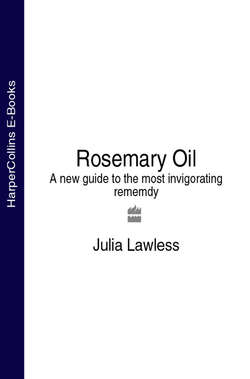Читать книгу Rosemary Oil: A new guide to the most invigorating rememdy - Julia Lawless - Страница 6
Rosemary Oil: An Introduction
ОглавлениеRosemarie, the chiefest beauties of Gardens and not to be wanted in the Kitchen.
B. Googe, Four Books of Husbandry (1577)
Rosemary has been called the ‘Prince’ of aromatic herbs – and it is not difficult to understand why! This handsome evergreen shrub with narrow, dark green leaves and small blue or mauve flowers has been cultivated since ancient times and is still a familiar sight in many gardens today. The flowers and ‘needles’ are endowed with the most delightful, refreshing scent, and rosemary has always been valued as one of the most important culinary herbs, having a strong, distinctive flavour. It has also been highly esteemed for its medicinal and cosmetic properties for thousands of years, and once played a central role in many traditional rites and ceremonies.
Rosemary belongs to the large botanical family Labiatae (Lamiaceae) along with lavender and many of the other common aromatic herbs, including marjoram, sage, thyme and mint. The native habitat of the wild rosemary (Rosmarinus officinalis) is Asia Minor and southern Europe; like lavender, it thrives in the Mediterranean region. It can still be found growing in profusion along the Mediterranean coastline, on the Balkan Peninsula, throughout Spain and Portugal and, to a lesser extent, in Turkey, Egypt and the Lebanon. It is one of the few shrubs that can survive the rigorous climate of the Sahara desert, although it is more at home growing in proximity to water. Indeed, its name is derived from the Latin ros (dew) and marinus (sea), meaning ‘Dew of the Sea’.
Rosemary has probably been cultivated in Great Britain for over 600 years, having been introduced by the Romans. Some sources say that it then went out of cultivation until the fourteenth century, when it was re-introduced by Queen Philippa, wife of King Edward III. Today it can be found growing in gardens throughout the world, even as far north as Canada, Scandinavia and Russia. In more northerly climes, however, it rarely grows taller than 1.2 m (4 ft) high, whereas in its natural habitat Rosmarinus officinalis can reach 1.8 m (6 ft) or more in height. It is also slightly frost-tender and needs the protection of a cold frame or the shelter of a south- or west-facing wall to survive a cold winter. Neither will rosemary tolerate water-logged conditions, and is best grown in well-drained limey soil or in a pot containing lots of broken crockery to ensure good drainage.
Rosemary is a favourite with gardeners and is often grown purely as a decorative plant both for its scent and for its fine stature. Gertrude Jekyll writes in her book House and Garden ‘… ever-blessed rosemary all over the garden, so that at every few steps the passer-by can run his hand over the blue-flowered branchlets and smell the warm resinous incense in his palm.’
Sir Thomas More let it run all over his garden walls because, he wrote, ‘My bees love it.’ Other men have apparently been more cautious about letting it grow too freely! There is an old folk belief that says ‘where rosemary flourishes, the woman rules’:
There is a vulgar belief in Gloucestershire and other counties, that Rosemary will not grow well unless where the mistress is ‘master’; and so touchy are some of the lords of creation upon this point, that we have more than once had reason to suspect them of injuring a growing rosemary in order to destroy this evidence of their want of authority.1
There are now many different cultivars or species available to the gardener, each with differing flower and leaf colours. The flowers can be bright blue, purplish-blue, pink, white, pale mauve or a soft, powdery blue. The needle-like leaves can vary from a dull, dark green to a variegated silver or golden form. However, the green-leaved common rosemary (R. officinalis var. officinalis) is the only type used medicinally and is the variety usually employed for the production of essential oil. It is also generally the type used for cooking.
Other well-known cultivars, some of which are occasionally used for essential oil production, include:
Rosmarinus officinalis var. albus: the white-flowered variety, quite rare
R. officinalis var. argenteus: a rare silver-leaved variegated form
R. officinalis var. aureus: a half-hardy, golden-leaved variegated form
R. officinalis ‘Benenden Blue’ (sometimes known as ‘Blue Lagoon’: green-leaved with bright blue flowers
R. officinalis var. fastigiatus ‘Miss Jessup’s Upright’: an erect, compact shrub often grown as a hedge
R. officinalis var. roseus: a form with rosy-pink flowers
R. officinalis var. lavandulaceus (procumbens): a tender, low-growing species sometimes used for the production of an essential oil
R. officinalis ‘Severn Sea’: a decorative species with brilliant blue flowers
R. officinalis var. angustifolia (tenuifolius): a pine-scented species occasionally used for the production of an essential oil.
